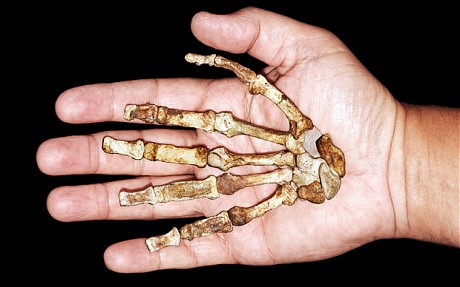Scientists in South Africa say they have discovered a potential missing link in the evolutionary chain, after they claim to have found the fossilised remains of our earliest ancestors.

The ancient remains of two human-like creatures found in South Africa could change the way we view our origins.
Humans are thought to have descended from a creature called Homo erectus, which lived more than a million years ago, and it in turn was descended from more primitive species.
Palaeontologists have unearthed the remains of a primitive ape-like creature which they believe could be the man's earliest ancestor that lived almost two million years ago.
The hominin, named Australopithecus sediba, was discovered in a cave in South Africa and has been dubbed the "missing link" between apes and humans.
From head to toe, the bones reveal an unexpected patchwork of primitive and advanced traits, the researchers reported in the journal Science. The tiny skulls, long arms and diminutive bodies were all chimp-like; yet the hands, ankles and pelvis were surprisingly modern.
After examining A. sediba's anatomy, for instance, scientists think they may have evidence that the species was capable of making and using tools.
In addition, the team thinks it may have found samples of fossilized skin. If confirmed, the discovery would mark the first time any type of soft tissue has been recovered from an early human ancestor.

Uranium lead dating of the flowstone, conducted by the University of Melbourne, combined with palaeomagnetic analysis of sediments surrounding the fossils, conducted by La Trobe University, provide the tightly constrained new age.
The team was able to pin down the age of the fossils to within 3000 years of 1.98 million years, a massive advance on the age range of around 200,000 years from the 2010 estimate.
Scientists analysed the brain, pelvis, hands and feet of the Australopithecus sediba that existed around the same time when early Homo species first began to appear on the earth. The analysis shows that Australopithecus sediba had 'mosaic' nature of the hominin's features.
Whatever the correctness of the analysis, the creature certainly has a fascinating mix of features - some archaic, some modern.
Independent scientists describe the fossils as exquisite and utterly fascinating.
Humans are thought to have descended from a creature called Homo erectus, which lived more than a million years ago, and it in turn was descended from more primitive species.
Palaeontologists have unearthed the remains of a primitive ape-like creature which they believe could be the man's earliest ancestor that lived almost two million years ago.
The hominin, named Australopithecus sediba, was discovered in a cave in South Africa and has been dubbed the "missing link" between apes and humans.
From head to toe, the bones reveal an unexpected patchwork of primitive and advanced traits, the researchers reported in the journal Science. The tiny skulls, long arms and diminutive bodies were all chimp-like; yet the hands, ankles and pelvis were surprisingly modern.
After examining A. sediba's anatomy, for instance, scientists think they may have evidence that the species was capable of making and using tools.
In addition, the team thinks it may have found samples of fossilized skin. If confirmed, the discovery would mark the first time any type of soft tissue has been recovered from an early human ancestor.

Uranium lead dating of the flowstone, conducted by the University of Melbourne, combined with palaeomagnetic analysis of sediments surrounding the fossils, conducted by La Trobe University, provide the tightly constrained new age.
The team was able to pin down the age of the fossils to within 3000 years of 1.98 million years, a massive advance on the age range of around 200,000 years from the 2010 estimate.
Scientists analysed the brain, pelvis, hands and feet of the Australopithecus sediba that existed around the same time when early Homo species first began to appear on the earth. The analysis shows that Australopithecus sediba had 'mosaic' nature of the hominin's features.
Whatever the correctness of the analysis, the creature certainly has a fascinating mix of features - some archaic, some modern.
Independent scientists describe the fossils as exquisite and utterly fascinating.







0 comments
Post a Comment